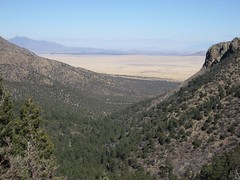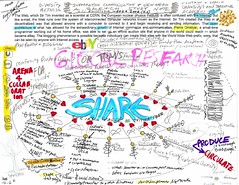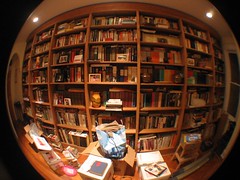The first thing that pops up on my aggregator this morning are some comments from Patti, at Tech and Teaching for High School. I must confess that I was a bit overcome by the excitement over the keynote that I did for the K12Online conference. It was very much off-the-cuff, and the concept of side trips and teaching from the rails sorta came out of the conversation I was having with the camera that day — still one of the weirder experiences I’ve had in the last ten years. So, I am surprised I’ve not seen more of these. So here are some of my reactions to Patti’s reactions.
Tech and Teaching for High School: David Warlick on “Derailing Education”:
Live in a time of rapid change…kids are a different generation
…but how do we make the things that were meaningful to us as students meaningful to them. How can I enforce the importance of a bibliography when students can just go online and put their information into a website that creates bibliographies? Why should a student ever visit a library when they can get entire books online? And how do we make that meaningful and important to them other than telling them these are skills they “should†have?
I would be the last to say, “Throw the baby out…” Especially when the baby is as important to them as it is to us. The ethical use of information is as important in our children’s digital networked information landscape as it was to our published print environment. In fact, it is far more important.
Our children will be content producers and intellectual property owners. A majority of the teenagers in the U.S. already are. Treating each others information with respect is now a personal issue, and a concept that can easily be addressed in the classroom as you teach students about copyright and creative commons within the context of their own reports, videos, web sites, and podcasts. If they are convinced of the value and worth of their own work, then they may come to want to respect the work of others.
In my talks and writings about contemporary literacy, I maintain that the ethical use of information is as much a part of literacy as being able to read and write.
Teach kids in a meaningful context only if we are connected to them through the new high tech culture…need to stop acting like immigrants
…I get the idea of meeting our kids on their level and finding ways to reach them that are meaningful. But does this just create more of a culture of instant gratification and self-indulgence? I really feel like my kids just expect everything to be handed to them. How can I challenge them and validate their context?
 |
1 |
| With the rail,
|
 |
2 |
| How can they be called,
|
 |
3 |
| Side trips?
|
I get your reaction, but I do not necessarity get the connection. We find ourselves teaching in a unique time. I suspect that you are a good deal younger than I am. I went to school in the 1950s and ’60s, and in that time, I could look at my Dad and see my future. When I started teaching (before the personal computer had been invented), I had every reason to believe that I would be doing what I was doing then, for the next 30 or 35 years. This is where we come from.
For our children, however, they understand that they will live in a time of rapid change. They are accustomed to it. Rapid change is an integral part of their experience. ..and teaching them from the perspective that this knowledge will serve you for the rest of your life, has very little meaning to them. It’s why it is so important to pay less attention to the content and more to the process. We have to teach our students how to teach themselves. It’s the best thing we can teach them.
I’m also coming to question this position that our children are after instant gratification. It’s certainly there. I have two kids. But I think that has come more from their growing up during a time of plenty and with parents who were/are eager to provide for them — almost to their detriment.
But within their information experiences, I suspect that there is great patience going on. It takes days to get through many of the video games, and sometimes much longer than that. In their virtual experiences, such as World of War Craft, they are willing to work many hours and days to achieve the wealth and the experience levels to achieve what they want. MySpace is the same. To get a truly impressive site, takes a very long time.
So I’m not convinced that teaching them from their information landscape and their information sentiments is directly related to instant gratification.
We can learn by sharing experiences only after we have them. Students can discuss what works for them and how they learn only after they have learned. I am not sure that the side trips can be the foundation. Without the foundation, how do you know what the side trips mean? Side trips can only be side trips in relation to the standard course. Or do we only know the standard course because we can define certain things as side trips? Either way, it is difficult to go on a side trip if you don’t have the rail to define the course for you.
I agree with you entirely here. I remember saying that the side trips should be the foundation of their education, but I also remember struggling with the right term here. What I wanted to say was that the side trips should be what they remember. When they think back to their schooling, it should be the side trips that they draw on for guidance and grounding.
The basics on the rails remain the foundation, because without a foundation, a main road, a corridor, a rail — how can it be called a side trip?
Image Citations:
1 Poff, Stephen. “February 17 2006.” Stephen Poff’s Photostream. 18 Feb 2006. 28 Mar 2007 <http://flickr.com/photos/stephenpoff/101272660/>.
2 “View from Water Canyon.” Gwarcita’s Photostream. 16 Jan 2007. 28 Mar 2007 <http://flickr.com/photos/johnida/359547074/>.
3 Fernandez, Maria. “feel the goose.” Maria’s Posts’ Photostream. 1 Feb 2007. 28 Mar 2007 <http://flickr.com/photos/callahanposts/376915351/>.




 As I read this, I got the sense that she really isn’t writing to an outside audience as much as she is to herself. It’s bread crumbs, dropped to mark the place where she is and how she got there. She (we) are laying a trail to ourselves. When I write in my blog, I’m trying to describe myself, where I am, who I am, and, perhaps even more, how I got here, why I think and believe what I do. I’m laying a trail to myself, as much so that I can find my way back, as much as for others.
As I read this, I got the sense that she really isn’t writing to an outside audience as much as she is to herself. It’s bread crumbs, dropped to mark the place where she is and how she got there. She (we) are laying a trail to ourselves. When I write in my blog, I’m trying to describe myself, where I am, who I am, and, perhaps even more, how I got here, why I think and believe what I do. I’m laying a trail to myself, as much so that I can find my way back, as much as for others.


 Let’s say that your school administration and board of director/education have just given you free reign to re-purpose and restructure your school library. They’ve latched on to the Library 2.0 movement as an opportunity to reinvent that room in the middle of the school.
Let’s say that your school administration and board of director/education have just given you free reign to re-purpose and restructure your school library. They’ve latched on to the Library 2.0 movement as an opportunity to reinvent that room in the middle of the school.  So this week, while on spring break from University of North Texas, he was given a tour of the very impressive Computer Science Program at UNC-Charlotte — personally led by the chair of the department. I’d love to say that it was my fame in the field of technology that warranted this personal treatment, but, to no surprise, it wasn’t.
So this week, while on spring break from University of North Texas, he was given a tour of the very impressive Computer Science Program at UNC-Charlotte — personally led by the chair of the department. I’d love to say that it was my fame in the field of technology that warranted this personal treatment, but, to no surprise, it wasn’t.